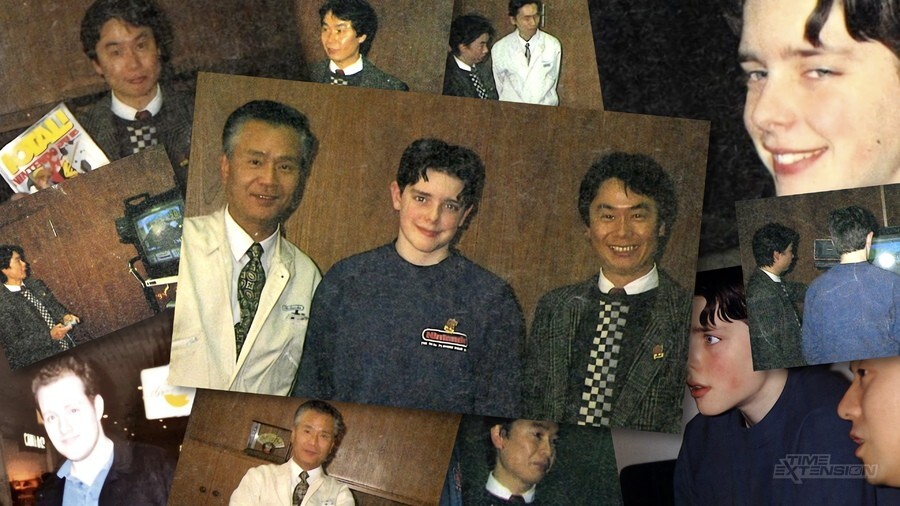
If you'd read the November 1993 issues of British games magazines Super Play, Total!, or Game Zone, then you may have come across a competition card offering the trip of a lifetime. Its tantalising Willy Wonka-style proclamation was hard to miss: "FANCY VISITING JAPAN? YOU COULD BE GOING AS A GUEST OF NINTENDO!"
Such an opportunity would be utterly mind-blowing today, but if you lived through that particular era, you'd know it was even more so back then. This was the height of the 16-bit console wars, with Nintendo and Sega battling for the hearts and minds of players. Sony's PlayStation launch in Japan was still more than a year away. Shigeru Miyamoto was a holy deity with few equals.
Keep in mind also that in 1993 visiting Japan from the UK was less easy than it is now. For one thing, English language signs across the Tokyo underground weren't fully implemented until the 2002 football World Cup. Furthermore, the World Wide Web was only a couple of years old, and nothing like it is nowadays.
Japan would have felt further away than it does today – and Nintendo was even more mysterious. This competition would have seemed almost implausibly ambitious; a real-life 'Golden Ticket' for gaming fans. Future Publishing, which produced the three magazines in question, had secured something truly unprecedented.
The Prize Of A Lifetime
To have a chance of winning, all one had to do was answer three easy questions (spoilers: 'Edmond', 'Brooklyn', and 'Super Famicom') and send the card in. Given that magazines were published with the subsequent month's date, you would have seen these issues around October 1993. For such a grandiose prize, the coverage was somewhat muted. Super Play mentioned it on page 25, dedicating a quarter of a page; Game Zone squeezed it onto less than a fifth of page 14; Total! shoehorned it into the coming next month page right at the back.
Each magazine described things a little differently. Super Play gave the most info, detailing the sort of fun the winner would get up to, and correcting the travel dates mentioned on the card: the trip would take place later in 1994, not between 26th and 31st December. The drawing would take place on Saturday, 13th November, at the Second Future Entertainment Show. This was an impressively large four-day event – issue 13 of Game Zone dedicated nearly a whole preview page.
Interestingly, each magazine suggested a different editor would join the winner: James Leach for Super Play, Trenton Webb for Game Zone, and "Fat Frankie" for Total! (AKA: Frank O'Connor). In addition, there would be a representative from Nintendo UK along for the ride.
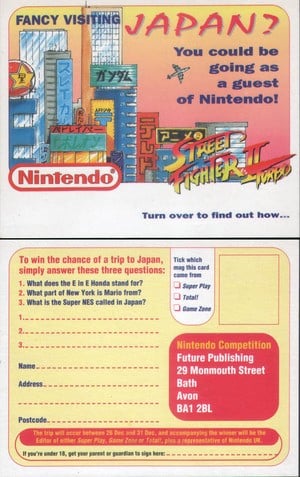
We've covered video game-related competitions before, such as the Castlevania III: Dracula's Curse sweepstakes competition by Konami, which promised a holiday to Transylvania (modern-day Romania). In that instance, we've yet to ascertain if anyone actually received the prize – but what about this Nintendo competition, which seems too good to be true?
Well, the prize was quite real. Gareth Bailey of Cornwall won it (then aged just 13), editor Frank O'Connor of Total! accompanied him, and some very cool things happened. Seemingly no one from Nintendo UK joined them. How do we know all of this? Well, we did it the old-fashioned way and cold-called a 'Gareth Bailey' based in Cornwall while he was at work. "This is going to sound bizarre, but did you travel to Japan in 1994?" was our opening gambit. "I might have done!" laughed Bailey over the phone nervously (in fairness, it was nearly 30 years ago). We explained the article being researched. "It is me, yes, but obviously, I'm at work at the moment..."
He very graciously agreed to be interviewed via email, later explaining: "I can't recall how the competition came about, I just remember seeing a card on the front of the magazine (Total!) and thought I'd fill it out and send it off. I never usually entered competitions if I had to cut out an entry form, but the card was stuck on the front, so I thought I'd give it a go."
Total! editor Frank O'Connor was somewhat easier to find. He left publishing in 2004 and clocked up 19 years of contiguous work on the Halo series, including content and community manager, then writer at Bungie and Franchise creative director at 343 Industries. He decided to stay with the franchise at Microsoft after Bungie became an independent studio again and is currently Franchise Creative Director for the entire Halo series, and served as an Executive Producer on the recent Halo television series for Paramount. (You could say he's sort of a big deal these days.) Naturally, in our excitement, we misspelt his surname when asking if he was the journalist who visited Nintendo in Japan.
"I am! It's O'Connor, by the way, but you're in excellent company, since the government, websites, credit cards etc., all fall apart when presented with the devious apostrophe. I can give you some anecdotes that are, at least to me, very cool and interesting. I had a blast and got to meet Gunpei Yokoi, Shigeru Miyamoto, and even briefly Mr [Hiroshi] Yamauchi – and at one point was grilled by them on the state of UK console gaming in a very odd sidebar meeting."
With the two central figures in this adventure now found, it was time to re-read the magazine coverage of the time and weave together two narratives – those which were printed before and what the key protagonists recall now.
We asked Bailey how he felt when discovering he'd been chosen as the winner. "My mum received a phone call saying I'd won the trip, and they wanted to speak to me; I can't recall what was said though at the time," he recalls. "I can only remember thinking it was a prank, as my uncle and I used to play tricks on each other, and he was staying over at the time!"
Disbelief is something both Bailey and O'Connor brought up when discussing events. So how and why did it all come about?
The Origins Of The Competition
"I was first made aware of the possibility by my publisher," says O'Connor, referring to Jane Ingham (neé Richardson) of Future Publishing. "But it had come up in conversation with Nintendo's PR at the time, which was still sort of forming."
To understand why Nintendo collaborated with Future, you need to realise that before this competition Nintendo... Well, Nintendo didn't exist. Not in the UK, anyway – not properly, at least. While Nintendo was (obviously) headquartered in Japan and had a large corporate presence in America, it hadn't achieved the same foothold in Europe at this time and instead relied on third-party licensees for the distribution and marketing of PAL-standard consoles. Its European presence was hopelessly fractured between multiple region-specific companies. This is one reason Sega's Master System did so well in Europe; distribution partner Virgin Mastertronic would be purchased by Sega in 1991 and turned into Sega of Europe, giving Nintendo's rival a solid base from which to establish its system – the NES, on the other hand, didn't get the support or infrastructure it needed.
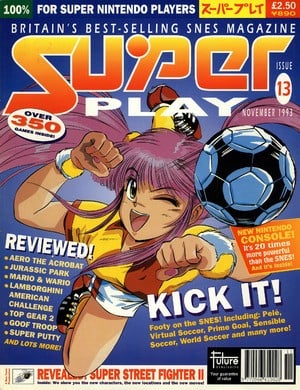
"The initial distributor [for Nintendo] was actually Mattel, so arguably its third console after the Intellivision 1 and 2 - a shaky 'fact' I intend to plant in a trivia quiz one day," explains O'Connor, helping us untangle the mess that was the PAL NES. "Eventually distribution and marketing fell to NESI - a company set up specifically to focus on console support, since Mattel had a lot of Kenneths, Barbaras, and so on to deal with (Ken and Barbie if you're reading this in the Colonies)."
David Sheff's excellent book Game Over provides a lot of background on Nintendo's attempt to enter Europe, starting on page 413 (unabridged edition). It all gets very convoluted. At one point, even Bandai handled distribution for Nintendo in the UK. Nintendo's own history page, however, mentions the official formation of 'Nintendo UK' in 1993 – the same year as the competition.
"The competition came about as a result of Nintendo UK trying to boost their visibility," confirms O'Connor. "We were as surprised as anyone it even happened. This was a push to do something splashy, customer-focused, and unique. It's an obvious iteration on the Charlie and the Chocolate Factory 'Golden Ticket' idea, which surprisingly – to the best of my knowledge – hadn't happened before."
(We also contacted the legendary former Future Publishing editor Steve Jarratt, who helped launch Total! magazine, hoping he might have further details from the managerial side. "Sorry," he replied, "I had nothing to do with this and had completely forgotten it ever happened! I have no recollection of being involved, sadly. How Frank managed to secure a free trip to Nintendo is beyond me. He always was a lucky bastard!")
Though the competition's inception is indeed surprising and mysterious, context tempers this a little. While Nintendo was trying to establish itself in Europe and especially the UK, it had to contend with years of weak licensee marketing and a big loss of market share to rivals Sega, compounded by inferior 50Hz PAL hardware and the rise of grey imports. Also, the SNES had only launched in the UK in April 1992, roughly 18 months before this competition. It was an ingenious marketing gimmick where the fledgling Nintendo UK could capture everyone's attention while also tapping into the Future Entertainment Show.
Beyond publicity, the competition gave Nintendo an opportunity to get a better handle on a market they perhaps didn't fully grasp yet. "Possibly they were just using me as a trial balloon or trying to get more local understanding," O'Connor suggests, going some way to explaining the 'luck' Jarratt mentioned. Future Publishing was the leading publisher of games magazines in the UK (it still is), and this trip would be delivering one of its games editors directly into Nintendo's interrogation booth.
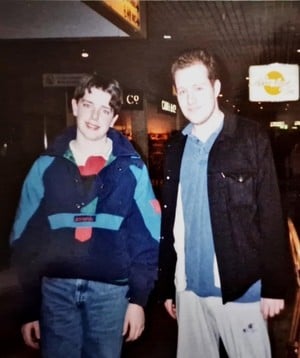
"The main purpose of the trip, obviously, was Gareth," O'Connor is quick to point out. "He was Charlie Bucket, of course, so a lot of the conversations were with him directly, and he was given the chance to talk to everyone – but I was taken aside for a bit and actually grilled on the state of Nintendo and the console business in the UK and Europe. Asked about trends, what people wanted, what the threats were, what tastes were, and so on. Useful to Nintendo, but also to me, as I was able to ask questions directly, but also infer and correctly assume a lot from the nature of their questions to me."
All of this conveys a logical framework for why Nintendo opened its door. The next question is, who funded everything? To give context, a later competition by the Nintendo Hotline from early 1995 had the millionth caller winning their height in games. As reported in Super Gamer issue 11 (February 1995), the winner was Alex Norton from Shrewsbury, who, at 5ft 4in, received around £3,000 worth of games. Two airline tickets to Japan, hotels for both travellers, transport plus other expenses would have cost a lot more than this.
"I am pretty sure Future paid for me, and Nintendo paid for him," recalls O'Connor. "Typically, Future would pay for travel etc., but this was a little different since we also had a prize winner accompanying. I'm not 100% sure; it's likely Nintendo arranged his travel and possibly accommodation, and we matched it. My recollection includes us (Future) finding a cheap ticket/hotel bundle, including a Japanese guide who helped from our arrival at Narita airport, and daily for the next couple of days as we prepared for the next leg to Kyoto by train."
"It was an all-expenses paid trip," adds Bailey, "although I took a bit of spending money to buy some Super Famicom games and a converter." Bailey also described the travel itinerary. "I travelled with Frank and spent three nights in Hong Kong, three nights in Tokyo, before catching the bullet train for another three nights in Kyoto."
The Trip Itself
Once finally in Japan, the actual 'Nintendo' part of the adventure was fairly brief; Nintendo is based in Kyoto, which accounted for only the final leg of the journey. O'Connor also took the opportunity to visit Konami in Kobe, but otherwise, there was a solid week's worth of recreation days for both. One interesting highlight is O'Connor's discovery of turtle stepping stones across the Kamo river in Kyoto, which look a lot like a real-life Mario game.
We asked Bailey to describe his big day at Nintendo. "We were picked up in the morning by a limo and escorted to Nintendo HQ," he remembers. "I've always been rubbish at getting up in the morning and had missed the trip to Konami a few days before, so thankfully, I didn't oversleep! When inside Nintendo, I remember the huge lobby/reception area being very white and clean. We were shown to the boardroom to meet with Shigeru Miyamoto, Gunpei Yokoi, and one other guy – still not sure who he was, a translator perhaps? I remember Shigeru Miyamoto and Gunpei Yokoi presenting me with their business cards which I immediately shoved in my back pocket, only finding out afterwards that's an insult in Japan. Apparently, you're supposed to take the card with two hands and study them."
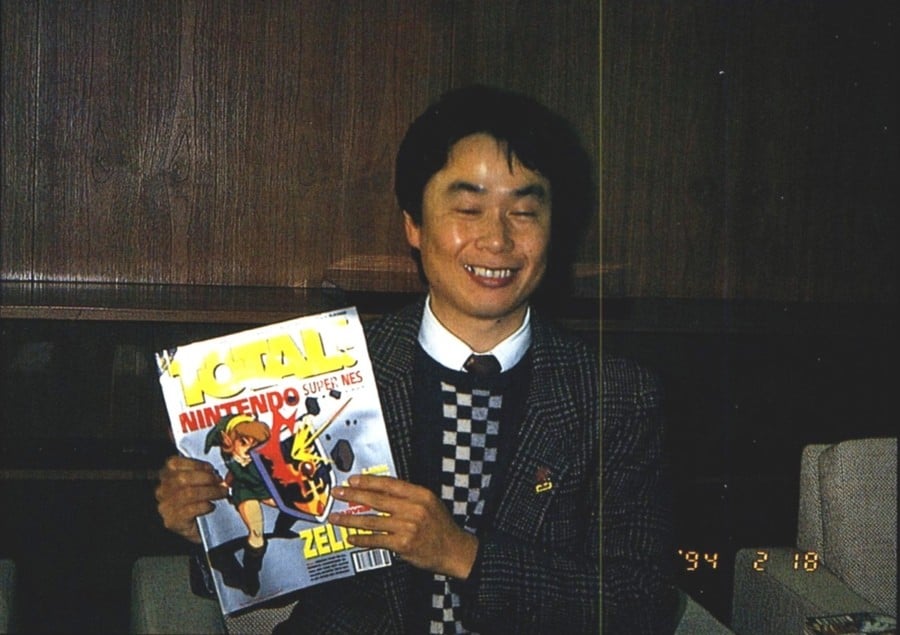
O'Connor description of the day's start is similar. "The Wonka aura quickly dissipated when you arrived at Nintendo's HQ – it [was] a low office building in an office park. A kind of uninteresting rectangle, big black glass windows, and little magic visible outside. We were greeted by a Nintendo translator. The day was structured – a meet and greet with our handler, translator etc., and a 'tour' which was carefully limited to parts of the operation that wouldn't reveal any secrets – something we did dozens of times at Bungie and 343 Industries, including covering monitors or hiding materials."
Bailey backs this up. "We were shown around the development areas but understandably weren't allowed to take any photos. In fact, I don't have any photos at all of that day. I'm assuming they were quite strict on taking pictures unless I was just so in awe I completely forgot to take any. I do apologise that my memory is a bit hazy now; it was all a bit surreal for me at the time." We reassure him we'd all be a little starstruck on such a trip, more so if only 13 years old!
Everything That's Fit To Print
It's interesting to contrast the modern recollections of O'Connor and Bailey against magazine coverage from back in the day, which was very careful in how it portrayed Nintendo's secrecy.
Coverage of the eventful trip started appearing in magazines around April of 1994. Super Play #19, dated May, featured a cover strap and ran a spread on pages 26 and 27. It previewed Super Metroid, Stunt Race FX, and Sound Fantasy (which would ultimately go unreleased). There were also hints regarding the N64 (Project Reality), the possibility of a Pilotwings sequel, and confirmation of a Super Mario World sequel (which would turn out to be Yoshi's Island).
The biggest coverage was in O'Connor's own magazine, Total!, which mentioned the trip on the cover and ran a whopping nine pages worth of content. Three were dedicated to the trip itself (mainly a history of Japan); two pages visiting Konami while in the neighbourhood; two pages on visiting Nintendo; two pages dedicated to interviewing Shigeru Miyamoto.
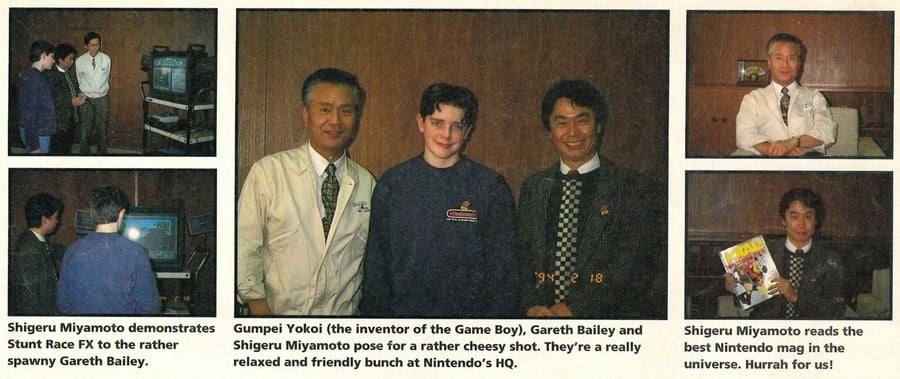
Sadly, by this time, Game Zone was on its last legs and, seemingly, had no coverage of the trip at all. The last issue was #18, dated April 1994. There was, however, coverage in the American magazine Game Players, volume 7, number 5, dated May 1994. It reprinted some of the Total! interview with Miyamoto, and featured a photo of Bailey, though misnamed him 'Gareth Brooks'. All of the photos of Bailey from Super Play and Total! were electronically dated 18 February 1994.
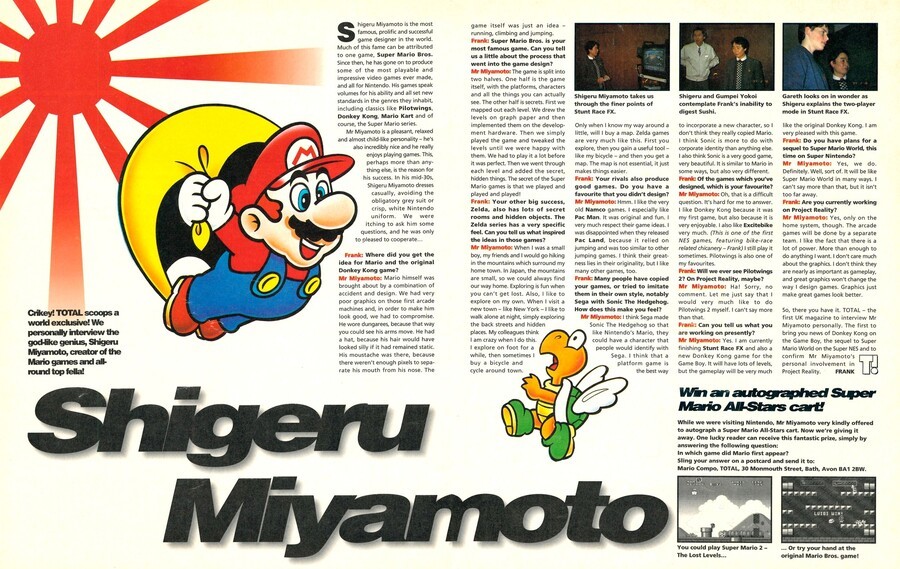
What about the rest of the day? "Things rolled along – tour, quick chat, demo etc., but the highlight for me was when asked if we wanted to see a new game in development that hadn't been shown to the press yet," explains O'Connor. "Nintendo was still sort of finding their way in Europe at the time and taking the position that most folks weren't super familiar with some of their franchises, but the surprise game demo? Super Metroid on SNES. I almost fainted dead away. And they let us play it! Seeing the game, while excellent, paled with the chance to meet with, talk to, and appreciate our 'demo guy' – the late Mr Gunpei Yokoi, who, far too soon after we met him, was taken from us by a car accident." (Yokoi, the creator of the Game & Watch series and Game Boy, was tragically killed in a road traffic accident in 1997.)
And the very odd sidebar meeting O'Connor mentioned earlier? "Nintendo, as I mentioned, was keen to expand in Europe, but unlike the US and Japan, Europe was neither a contiguous landmass nor a contiguous market. The differing power and video systems, confusing market borders, exchange rates, and so on, made business there frustrating and expensive. We talked about those barriers."
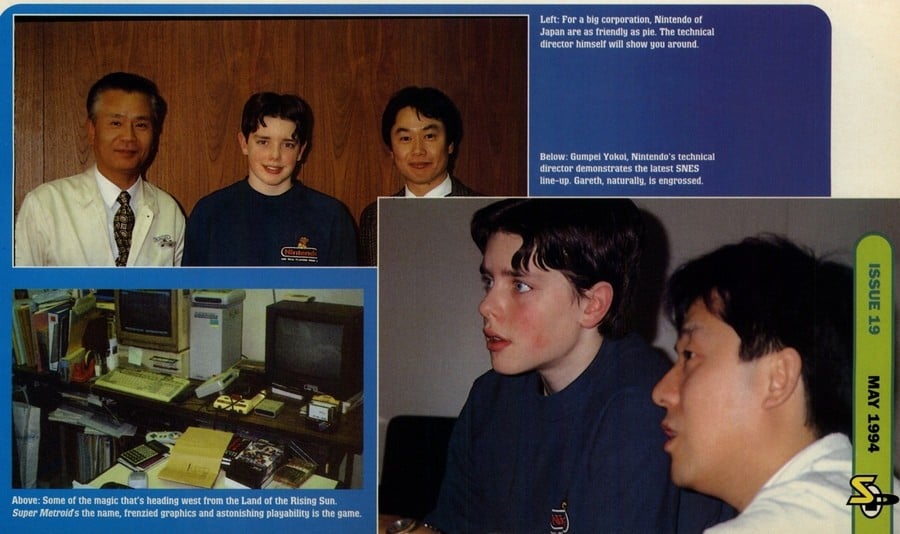
O'Connor gave us a detailed account of how Nintendo perceived Europe and the grey import market that was flourishing at the time, which we're saving for a later article. It's especially interesting when you consider the Euro currency was only introduced in 1999 – the year of his trip, 1994, would have still been a wild west for anyone entering the European market.
"After O'Connor had finished the interview [with Shigeru Miyamoto], we were served lunch," says Bailey, confirming an anecdote regarding sushi which was mentioned in Total!'s coverage of the visit. It was, as he explains, "some sort of raw fish, which certainly wasn't my sort of thing back then. Everything the magazine says about hiding my food under the rice is all true!"
At some point, though, the fun had to conclude. "Before we left, I was presented with a couple of gifts," explains Bailey. "a Mario World watch – which I wore to school and managed to scratch up! – and a Nintendo [uta-garuta or poetry] card and cassette tape set, both of which I still have in my 'Japan trip' box. The tape was an audio cassette, part of the card set; I remember playing the tape once, it had some Japanese-style singing or music on it."

We asked Bailey how it felt being in a foreign land, chaperoned by a stranger. "I feel sorry for Frank having to look after a timid 13-year-old me and not being able to see what the Japanese nightlife had to offer! I'd always wished I was a little older at the time and have hoped to return one day. We did, however, go bowling and ice skating, both of which were a first for me."
O'Connor, however, confirms that he had the time of his life on the trip. "Because he was a minor at the time, I was pretty limited in what I could actually do with Gareth outside of the prescribed itineraries, and I might conflate, for example, my discovery of turtle stepping stones as pedestrian bridges across Kyoto's canals – which has a very obvious implication for the Mario universe! – and walks I took with Gareth. While my impression was [that] Gareth enjoyed it too, I can't be sure. I hope he found it as fascinating and exciting as I did, even though I was pretending to be a mature grownup."
Life After Nintendo
After the dream trip ended, both travellers would return home. Their flight would be diverted to a different airport, but life back in England would resume.
"I came away from the trip with loads of memories, content for magazines, and fundamental appreciation for Nintendo's 'secret sauce'," recalls O'Connor. "It was in many ways a traditional studio – a lot like Hudson Soft or Konami once you got into the building – but like all real magic, it was invested in the imagination, philosophy, and power of its various wizards – its power dependent on how those spells are executed and how they are amplified and focused by teamwork and collaboration."
Bailey, meanwhile, would have had to return to school and resume studying for his eventual GCSEs and beyond. In time, he would start a family and come to be head of his own company, Cornwall Bookkeeping & Accountancy Services. "I always wanted to work in the gaming industry from a young age," he says nostalgically, "but unfortunately, down here in Cornwall, there just aren't those opportunities."
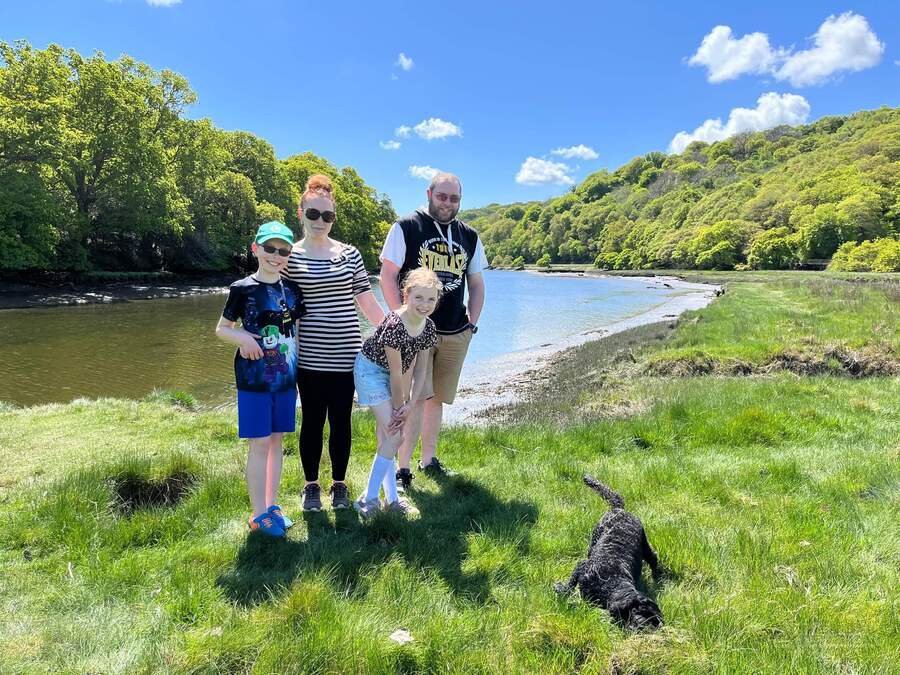
Having tracked down these two men after so long, one can't help but feel a little melancholy, reflecting on lost youth and the rare chances one has in life. "Balancing the opportunity I had as a journalist," says O'Connor, "with the responsibility for ensuring Gareth was enjoying himself, is something I will never be sure I got right. To be honest, I was in my early twenties, and Gareth was a squire – a young man closer in age to me than I was to most of the people we met. And I probably overcorrected and undercorrected the entire trip, desperately wanting to make sure he enjoyed the trip, wasn't nervous or ignored, while remaining physically intact and unharmed – no moonlight turtle jumping, then."
It's been nearly 30 years since Bailey and O'Connor boarded an aeroplane to meet the greatest game designers on Earth. Video games and the world have changed a lot since then. Researching this article, it's difficult not to look back at their experiences and yearn for that more innocent time, before the web, before instant news, when everything felt just that little bit more exciting and novel.
Bailey's lasting sentiment is one of gratitude for having an opportunity we can only imagine today. We'll give him the final comment. "Could you thank Frank for me, please?" he says. "I was a kid of very few words back then and can't remember thanking him. I'm sure I must have at the time, but it seriously couldn't have been easy for him to look after a 13-year-old in a foreign country! I had an amazing time, even though he did whip me at bowling. I was very competitive as a youngster. I think I used up a lifetime of luck winning that competition, I've won pretty much next to nothing since then – although I did have a bit of a flutter at the start of the 2023 World Cup and predicted France and Argentina would both reach the final, which is nice!"
